Niteye are making their own mark on the flashlight scene, and have designed a range utilising an interesting rotary magnetic / button combination tail-switch. The focus of this review is one of this new range of Military Series lights, the MSC20 model.
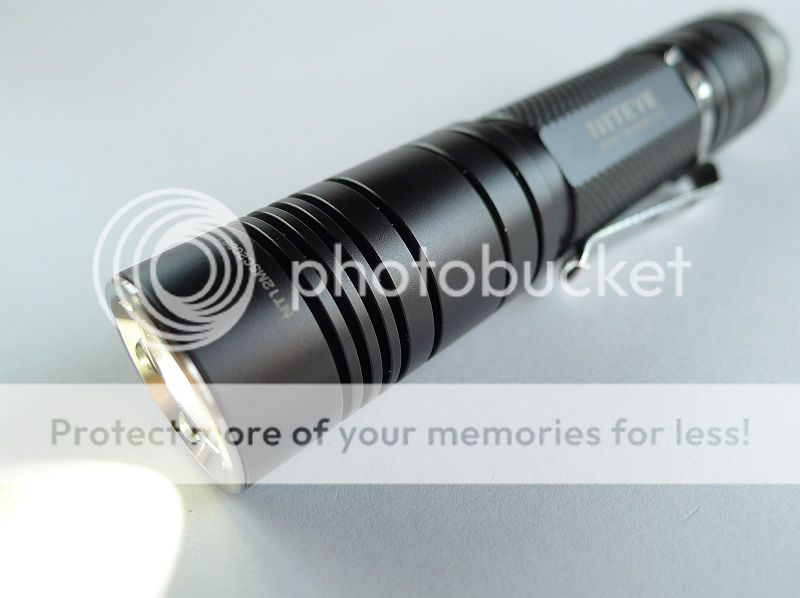
Initial Impressions:
The two previous Niteye samples I've reviewed (Eye 30 and Eye 10) have set a high standard for Niteye, and the MSC20 stands up to this.
Fit, and finish are excellent, and the switch operates very smoothly, both in rotary action and the button.
The tail-switch control ring / button is quite different, and the concept grows on you very quickly.
So straight out of the box this light impresses, but where this light really stands out for me is when you first see the beam. One of the best I've used, and equal to the excellent beam of the Eye 10.
Very quickly I really like this light.

What is in the box:
In what appears to be a standard Niteye / Jetbeam cardboard box (as the sample Jetbeam DDA10 arrived in a similar box)
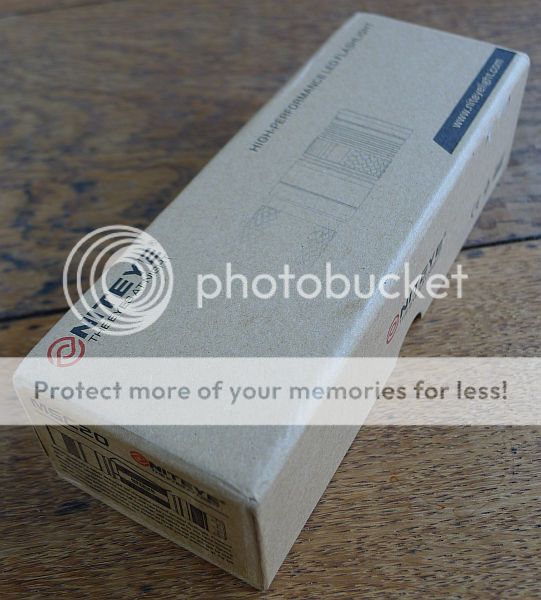
Inside the light is protected by a foam rubber liner.
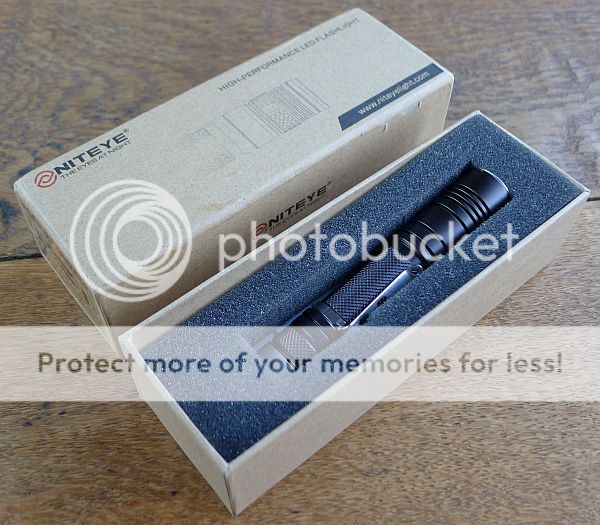
It is shipped with two spare o-rings, and instructions, and nothing else. (I wish it had a holster as this is a great compact carry light, but no holster is included)
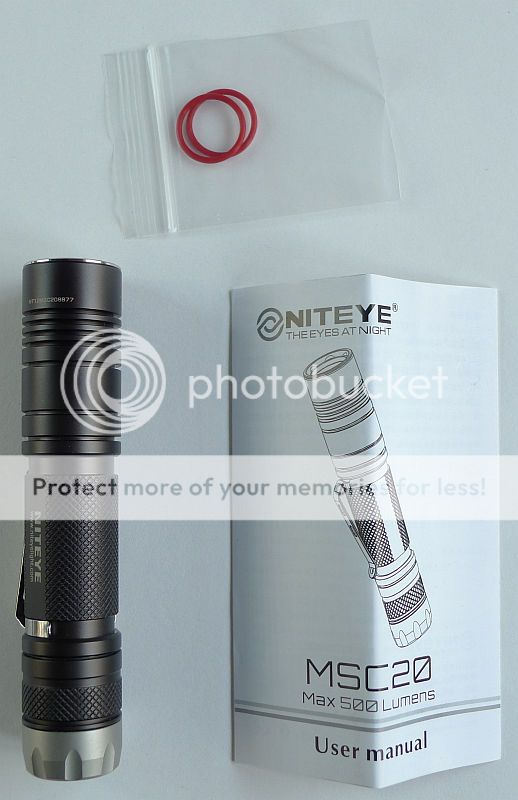
Taking a closer look and looking inside:
The MSC20 is supplied with a pocket clip already attached.
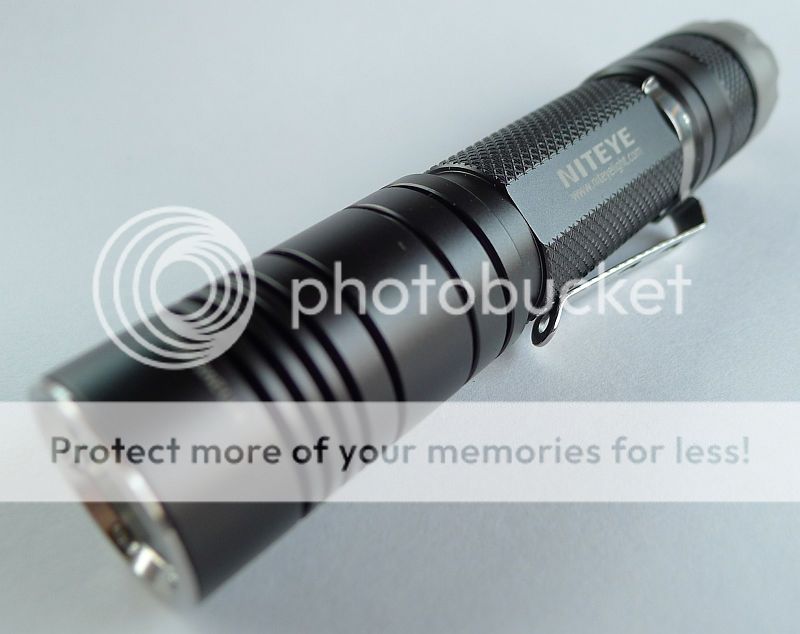
The writing is laser etched into the anodised surface.
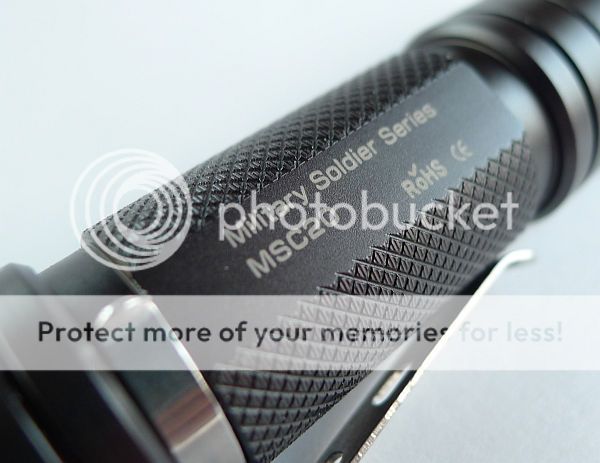
Now the distinctive feature of this light, the control ring / button switch. The centre of the tail switch is a click button (more on this in the UI section)
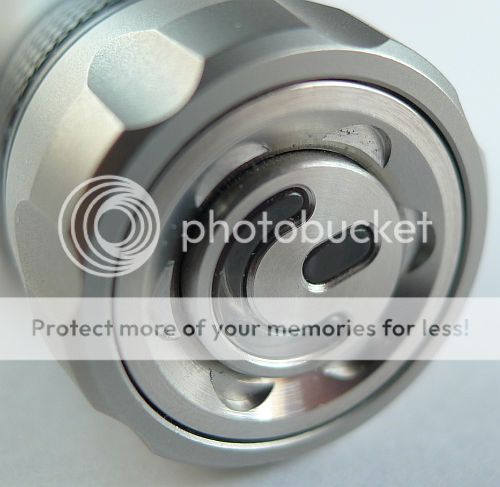
The control ring is finished to a very high standard with scallops to provide grip.
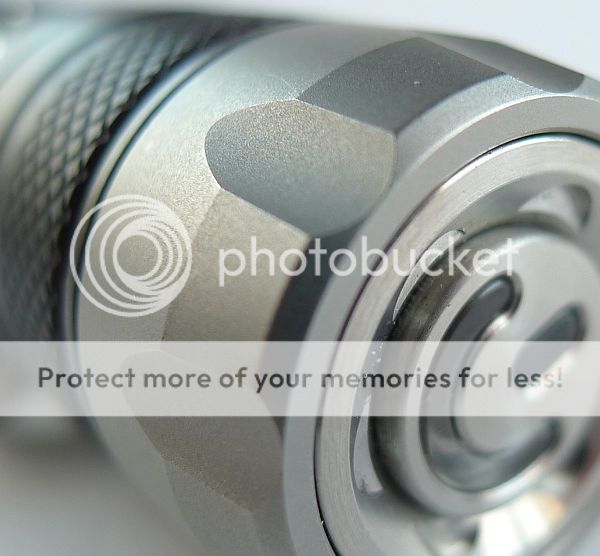
The button incorporates a clear window section through which a battery indicator light can be seen.
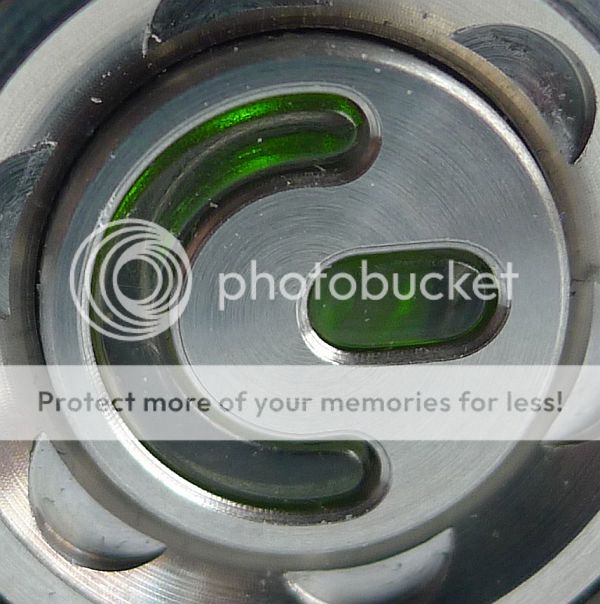
The MSC20 uses an XM-L U2 LED in a textured OP reflector.
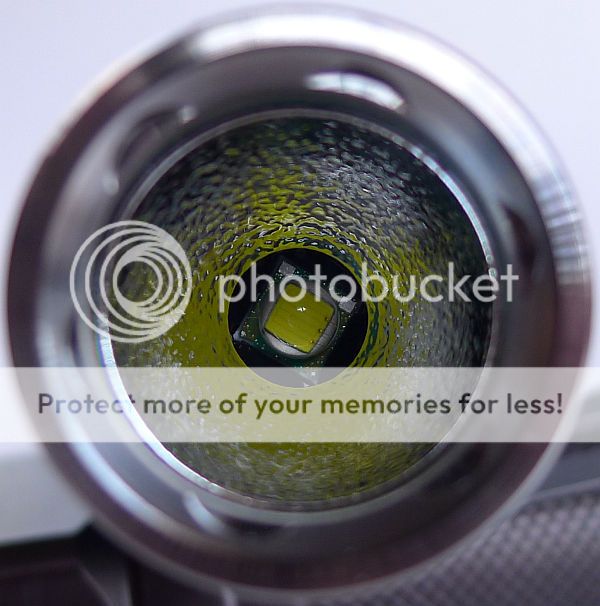
Both the head and tail unscrew from the battery tube. Bottom left, the physical reverse polarity protection can be seen. The positive terminal is surrounded by a cup shaped secondary terminal which requires a button top cell to properly make contact. You cannot use flat top cells due to this feature. Surrounding this is a circular gold plated contact for the battery tube to touch. The tail-cap on the right shows the negative contact spring, and the contact ring for the battery tube.
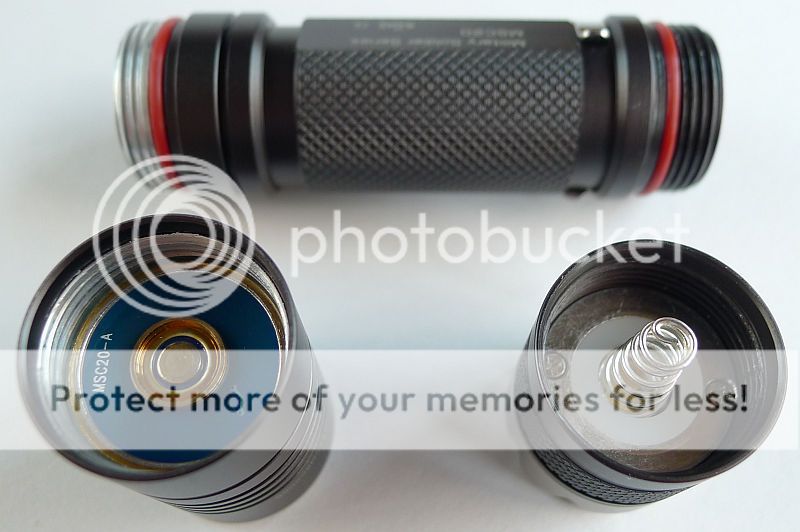
The threads are cleanly cut, and fully anodised. Finish is excellent.
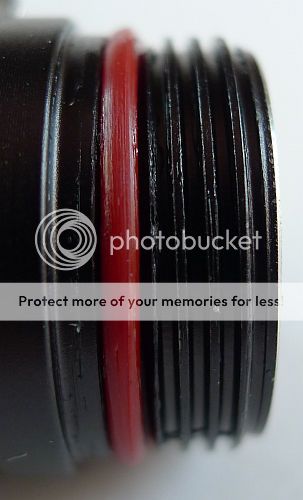
For scale the MSC20 is next to two CR123 primaries.
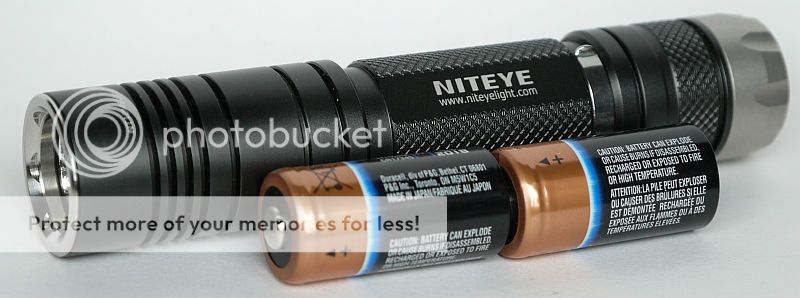
Modes and User Interface:
The MSC20's dual control tail-cap allows you to switch the light on and off in two ways.
Firstly there is the rotary control ring. This has four positions in all, Strobe, OFF, Low/custom and High.
Starting from OFF, turn it one click anti-clockwise (when looking at the end of the switch) and you get the strobe.
Starting from OFF, turn it one click clockwise (when looking at the end of the switch) and you get the low/custom mode, and then one more click to get High.
Now the button comes into play. In any output mode a press (and let go) will switch the light off, and press again to switch it back on to the mode selected by the control ring.
Rotating the control ring overrides this button switch.
As well as allowing you to directly switch any output mode on and off, in the Low/Custom output mode, pressing and holding the button in will adjust the custom output level setting. This will ramp up to the maximum, and you release the button at any point to choose that level. Pressing and holding again will ramp down to the minimum, even if you were not at a high level.
So for the custom output selection, the first press-and-hold of the button ramps up, and the second ramps down, third up etc.
The custom output level is memorised, but resets to the minimum output when the battery is changed.
The last feature to mention is the light behind the button switch. When the battery voltage is good, whenever the control ring is returned to the off position it shows a green light. When the battery voltage is low this will show as red.
Unfortunately, when the battery is getting low, the red light does not come on unless you switch the MSC20 off, so this feature does not give you a low battery warning when the light is on.
Batteries and output:
The MSC20 can run on 2xCR123/RCR123 or 1x 18650, but as mentioned previously you must use button top cells (flat tops will not work).
To measure actual output, I built an integrating sphere. See here for more detail. The sensor registers visible light only (so Infra-Red and Ultra-Violet will not be measured).
Please note, all quoted lumen figures are from a DIY integrating sphere, and according to ANSI standards. Although every effort is made to give as accurate a result as possible, they should be taken as an estimate only. The results can be used to compare outputs in this review and others I have published.
Testing has been carried out with Xtar 3100mAh cells and CR123
Strobe is a 12.5Hz
All output modes exhibit PWM however this is only really visible on the oscilloscope. On the oscilloscope however, the PWM frequency appears to be a mixture of multiple interfering frequencies (which is perhaps why it is not really visible to the eye) and it is not possible to get a clear frequency reading.
As it uses an electronic switch, there is parasitic drain. Interestingly while measuring this, it appears that all control circuitry is in the tail, as when I put the ammeter from battery tube to the battery's negative terminal, the LED came on brightly.
When I worked out how to get the measurement via the tailcap, the parasitic drain was an excellent 71 uA giving nearly 5 years to exhaust the 3100mAh test cell.
The following output trace shows a dip in output followed by a rise (which I suspect is due to the driver circuit slightly over compensating for battery voltage drop) after which a gradual decline in output. Nearly 2 hours after switching on high, the output has dropped to about 270lm and the low battery warning flashes start. Initially these drop to 150lm and back to >200lm and as the battery become more depleted, the flash drops to 0lm then back to around 200lm. As the battery gets even lower the time between flashes increases. The runtime trace was taken up to the point the batteries protection circuit cut off the power.
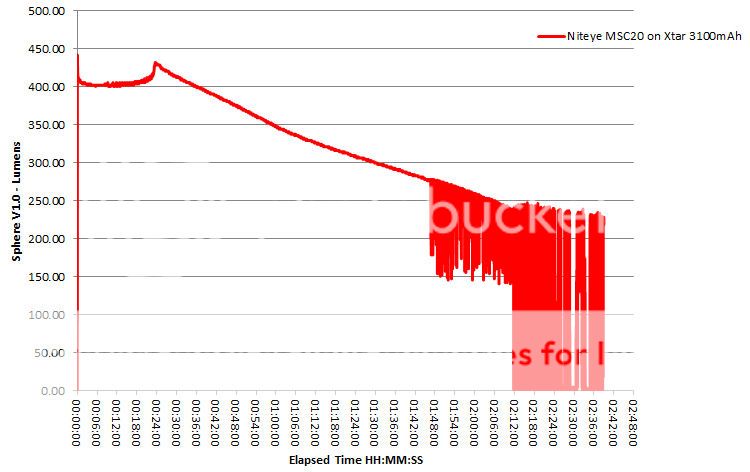
In The Lab
NEW for Winter 2012 ANSI standards include maximum beam range. This is the distance at which the intensity of light from an emitter falls to 0.25lux (roughly the same as the lux from a full moon). This standard refers only to the peak beam range (a one dimensional quantity), so I am expanding on this and applying the same methodology across the entire width of the beam. From this data it is possible to plot a two-dimensional 'beam range profile' diagram which represents the shape of the illuminated area.
In order to accurately capture this information a test rig was constructed which allows a lux meter to be positioned 1m from the lens and a series of readings to be taken at various angles out from the centre line of the beam. As the rig defines a quadrant of a circle with a radius of 1m, all the readings are taken 1m from the lens, so measuring the true spherical light intensity. The rig was designed to minimise its influence on the readings with baffles added to shield the lux meter from possible reflections off the support members.
The distance of 1m was chosen as at this distance 1lux = 1 candela and the maximum beam range is then calculated as the SQRT(Candela/0.25) for each angle of emission.
In this plot, the calculated ANSI beam ranges are plotted as if viewed from above (for some lights there may also be a side view produced) using a CAD package to give the precise 'shape' of the beam.
Starting with the 5m range grid, the MSC20's beam profile. The small OP reflector diffusing the light into a broad even spill.
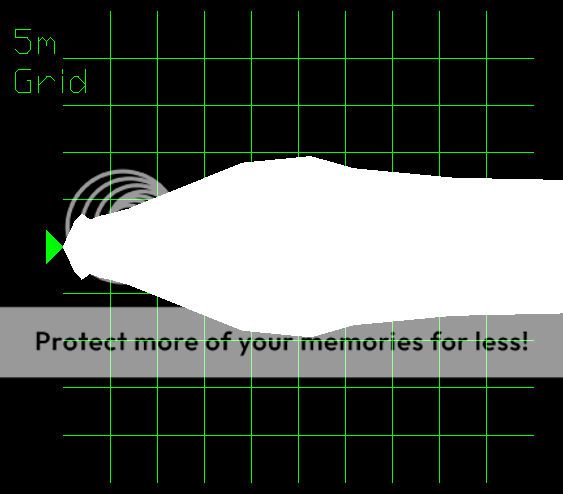
Zooming out to the 50m grid and here, the MSC20 has limited extended range as it has very good spill beam.
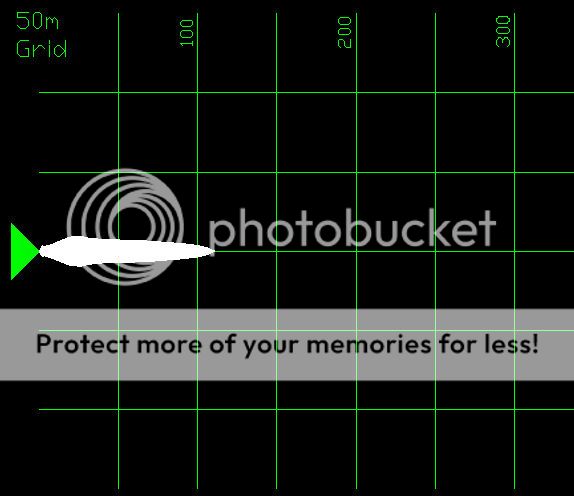
The beam
The indoor beamshot shows the lovely wide even spill with soft broad hotspot.
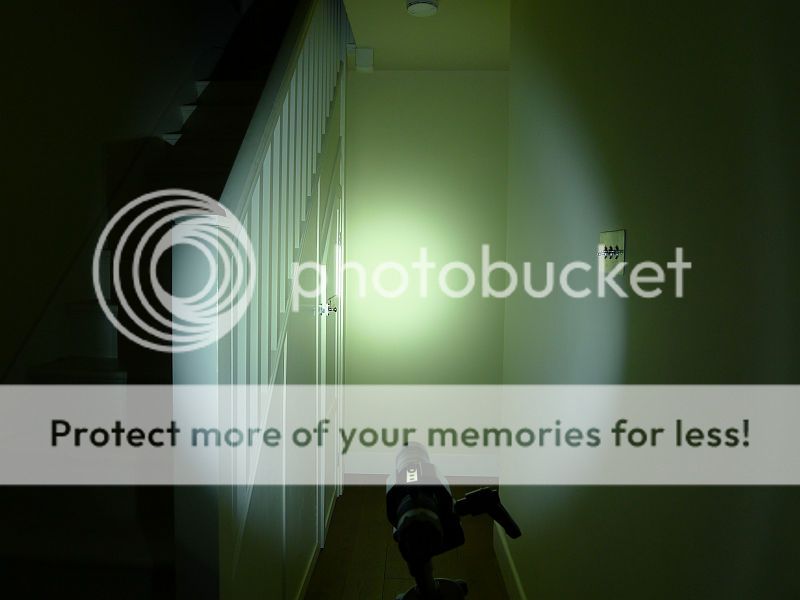
Outdoors really shows off the MSC20's even beam.
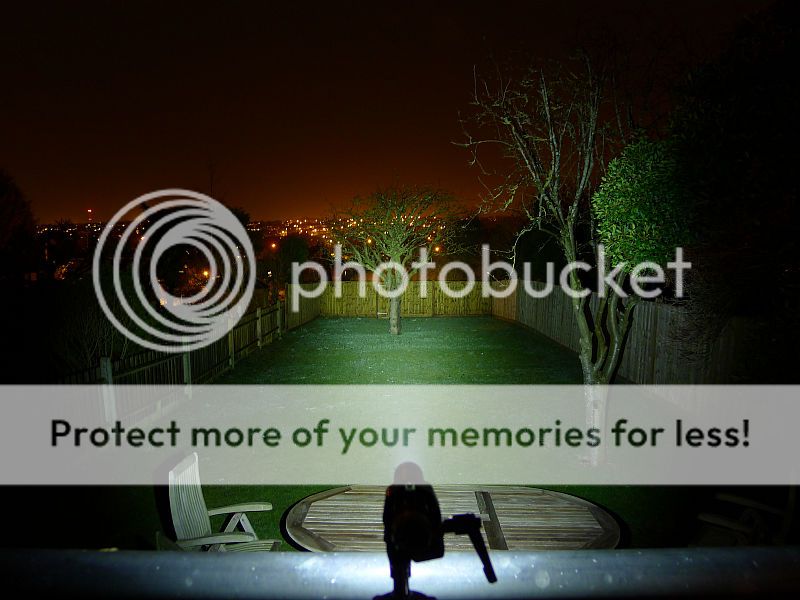
For ranges up to 30m, this is the perfect beam. It works really well indoors, especially using the custom output setting, but is easily powerful enough for outdoors use as well.
What it is really like to use…
This new combination switch is very intuitive to use, though I frequently find I forget that I have switched the light off using the button, and end up getting maximum output rather than the custom/low setting when I rotate the ring to switch it on (because this then turns it to the maximum output setting as it was already on the low setting).
The rotary control allows you to use the MSC20 one-handed, much like a small twisty light. If you wrap your little finger around the control ring, you can then rotate the light (as if twisting the head) easily between thumb and index finger, and switch it between modes. This seemed the most natural way to use it to me.
The button is nearly too stiff to use a cigar grip, instead a tactical grip is better to give the strength to use the button.
The combination switch provides flexible switching options and a variety of grip positions while still retaining control.
It feels like an EDC light, I want to carry it, so Niteye, please consider including a holster as this is the only thing missing from this excellent light.
I may have mentioned it before, but the beam is so easy on the eye, and so easy to use. The hotspot is very soft and the spill nice and bright. At close ranges and indoors, you do not 'hunt' around with the light if you are looking for something, just point it and let your eyes move to find what you are looking for.
Fantastic beam, excellent build quality, and a well-executed combination control ring/button switch, makes this a lovely light to use.
Test sample provided by Niteye for review.

Initial Impressions:
The two previous Niteye samples I've reviewed (Eye 30 and Eye 10) have set a high standard for Niteye, and the MSC20 stands up to this.
Fit, and finish are excellent, and the switch operates very smoothly, both in rotary action and the button.
The tail-switch control ring / button is quite different, and the concept grows on you very quickly.
So straight out of the box this light impresses, but where this light really stands out for me is when you first see the beam. One of the best I've used, and equal to the excellent beam of the Eye 10.
Very quickly I really like this light.

What is in the box:
In what appears to be a standard Niteye / Jetbeam cardboard box (as the sample Jetbeam DDA10 arrived in a similar box)

Inside the light is protected by a foam rubber liner.

It is shipped with two spare o-rings, and instructions, and nothing else. (I wish it had a holster as this is a great compact carry light, but no holster is included)

Taking a closer look and looking inside:
The MSC20 is supplied with a pocket clip already attached.

The writing is laser etched into the anodised surface.

Now the distinctive feature of this light, the control ring / button switch. The centre of the tail switch is a click button (more on this in the UI section)

The control ring is finished to a very high standard with scallops to provide grip.

The button incorporates a clear window section through which a battery indicator light can be seen.

The MSC20 uses an XM-L U2 LED in a textured OP reflector.

Both the head and tail unscrew from the battery tube. Bottom left, the physical reverse polarity protection can be seen. The positive terminal is surrounded by a cup shaped secondary terminal which requires a button top cell to properly make contact. You cannot use flat top cells due to this feature. Surrounding this is a circular gold plated contact for the battery tube to touch. The tail-cap on the right shows the negative contact spring, and the contact ring for the battery tube.

The threads are cleanly cut, and fully anodised. Finish is excellent.

For scale the MSC20 is next to two CR123 primaries.

Modes and User Interface:
The MSC20's dual control tail-cap allows you to switch the light on and off in two ways.
Firstly there is the rotary control ring. This has four positions in all, Strobe, OFF, Low/custom and High.
Starting from OFF, turn it one click anti-clockwise (when looking at the end of the switch) and you get the strobe.
Starting from OFF, turn it one click clockwise (when looking at the end of the switch) and you get the low/custom mode, and then one more click to get High.
Now the button comes into play. In any output mode a press (and let go) will switch the light off, and press again to switch it back on to the mode selected by the control ring.
Rotating the control ring overrides this button switch.
As well as allowing you to directly switch any output mode on and off, in the Low/Custom output mode, pressing and holding the button in will adjust the custom output level setting. This will ramp up to the maximum, and you release the button at any point to choose that level. Pressing and holding again will ramp down to the minimum, even if you were not at a high level.
So for the custom output selection, the first press-and-hold of the button ramps up, and the second ramps down, third up etc.
The custom output level is memorised, but resets to the minimum output when the battery is changed.
The last feature to mention is the light behind the button switch. When the battery voltage is good, whenever the control ring is returned to the off position it shows a green light. When the battery voltage is low this will show as red.
Unfortunately, when the battery is getting low, the red light does not come on unless you switch the MSC20 off, so this feature does not give you a low battery warning when the light is on.
Batteries and output:
The MSC20 can run on 2xCR123/RCR123 or 1x 18650, but as mentioned previously you must use button top cells (flat tops will not work).
To measure actual output, I built an integrating sphere. See here for more detail. The sensor registers visible light only (so Infra-Red and Ultra-Violet will not be measured).
Please note, all quoted lumen figures are from a DIY integrating sphere, and according to ANSI standards. Although every effort is made to give as accurate a result as possible, they should be taken as an estimate only. The results can be used to compare outputs in this review and others I have published.
Testing has been carried out with Xtar 3100mAh cells and CR123
| Niteye MSC20 using Xtar 3100mAh | I.S. measured ANSI output Lumens | PWM frequency (Hz) |
|---|---|---|
| High | 412 | See comment |
| Lowest Custom Setting | 7 | See comment |
| Highest Custom Setting | 328 | See comment |
| High on CR123 | 407 | 0 |
Strobe is a 12.5Hz
All output modes exhibit PWM however this is only really visible on the oscilloscope. On the oscilloscope however, the PWM frequency appears to be a mixture of multiple interfering frequencies (which is perhaps why it is not really visible to the eye) and it is not possible to get a clear frequency reading.
As it uses an electronic switch, there is parasitic drain. Interestingly while measuring this, it appears that all control circuitry is in the tail, as when I put the ammeter from battery tube to the battery's negative terminal, the LED came on brightly.
When I worked out how to get the measurement via the tailcap, the parasitic drain was an excellent 71 uA giving nearly 5 years to exhaust the 3100mAh test cell.
The following output trace shows a dip in output followed by a rise (which I suspect is due to the driver circuit slightly over compensating for battery voltage drop) after which a gradual decline in output. Nearly 2 hours after switching on high, the output has dropped to about 270lm and the low battery warning flashes start. Initially these drop to 150lm and back to >200lm and as the battery become more depleted, the flash drops to 0lm then back to around 200lm. As the battery gets even lower the time between flashes increases. The runtime trace was taken up to the point the batteries protection circuit cut off the power.

In The Lab
NEW for Winter 2012 ANSI standards include maximum beam range. This is the distance at which the intensity of light from an emitter falls to 0.25lux (roughly the same as the lux from a full moon). This standard refers only to the peak beam range (a one dimensional quantity), so I am expanding on this and applying the same methodology across the entire width of the beam. From this data it is possible to plot a two-dimensional 'beam range profile' diagram which represents the shape of the illuminated area.
In order to accurately capture this information a test rig was constructed which allows a lux meter to be positioned 1m from the lens and a series of readings to be taken at various angles out from the centre line of the beam. As the rig defines a quadrant of a circle with a radius of 1m, all the readings are taken 1m from the lens, so measuring the true spherical light intensity. The rig was designed to minimise its influence on the readings with baffles added to shield the lux meter from possible reflections off the support members.
The distance of 1m was chosen as at this distance 1lux = 1 candela and the maximum beam range is then calculated as the SQRT(Candela/0.25) for each angle of emission.
In this plot, the calculated ANSI beam ranges are plotted as if viewed from above (for some lights there may also be a side view produced) using a CAD package to give the precise 'shape' of the beam.
Starting with the 5m range grid, the MSC20's beam profile. The small OP reflector diffusing the light into a broad even spill.

Zooming out to the 50m grid and here, the MSC20 has limited extended range as it has very good spill beam.

The beam
The indoor beamshot shows the lovely wide even spill with soft broad hotspot.

Outdoors really shows off the MSC20's even beam.

For ranges up to 30m, this is the perfect beam. It works really well indoors, especially using the custom output setting, but is easily powerful enough for outdoors use as well.
What it is really like to use…
This new combination switch is very intuitive to use, though I frequently find I forget that I have switched the light off using the button, and end up getting maximum output rather than the custom/low setting when I rotate the ring to switch it on (because this then turns it to the maximum output setting as it was already on the low setting).
The rotary control allows you to use the MSC20 one-handed, much like a small twisty light. If you wrap your little finger around the control ring, you can then rotate the light (as if twisting the head) easily between thumb and index finger, and switch it between modes. This seemed the most natural way to use it to me.
The button is nearly too stiff to use a cigar grip, instead a tactical grip is better to give the strength to use the button.
The combination switch provides flexible switching options and a variety of grip positions while still retaining control.
It feels like an EDC light, I want to carry it, so Niteye, please consider including a holster as this is the only thing missing from this excellent light.
I may have mentioned it before, but the beam is so easy on the eye, and so easy to use. The hotspot is very soft and the spill nice and bright. At close ranges and indoors, you do not 'hunt' around with the light if you are looking for something, just point it and let your eyes move to find what you are looking for.
Fantastic beam, excellent build quality, and a well-executed combination control ring/button switch, makes this a lovely light to use.
Test sample provided by Niteye for review.

